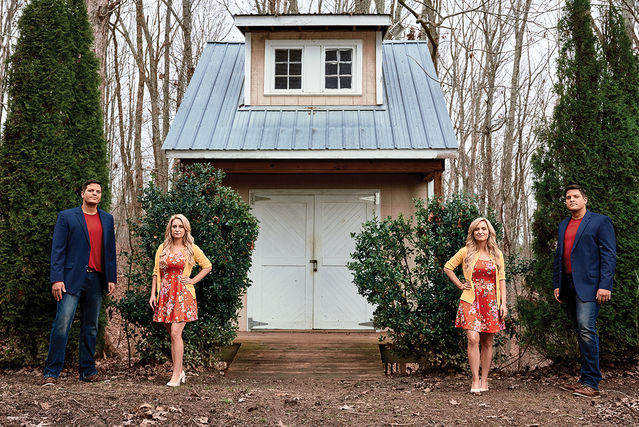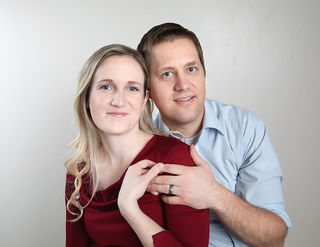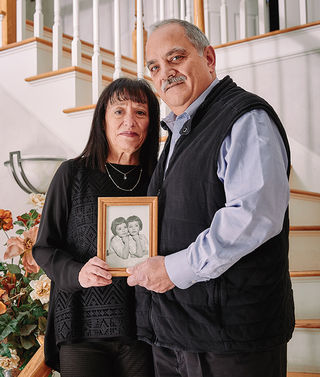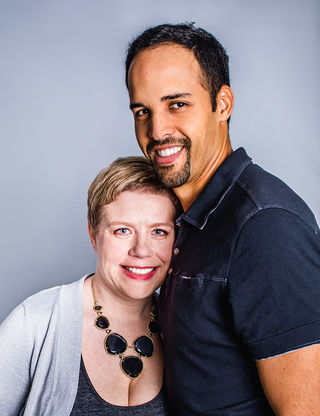The Forces of Attraction
Why we are attracted to certain people can seem like a mystery. But twins marrying twins and May-December couples shed light on the biology guiding mate choice.
By Jennifer Latson published March 4, 2019 - last reviewed on December 21, 2020

There's a science behind attraction, one that can be more complicated than physics—and significantly more awkward. Albert Einstein knew this better than anyone. In his thirties, Einstein grew so enamored of his cousin Elsa that he left his first wife for her. He and Elsa were twice related, since their mothers were sisters and their fathers were first cousins. The physicist wrote to his familial flame in a 1914 letter, "Dear little Else, I shall cherish you and be thankful for your love. You have proven that you felt attracted to me as a person and not to the great animal in the newspapers."
A few years later, however, he was ready to call off their engagement. Instead, he professed his love to yet another relative: Elsa's 20-year-old daughter, Ilse. "Albert himself is refusing to take any decision; he is prepared to marry either Mama or me," Ilse wrote to a friend. "I know that A. loves me very much, perhaps more than any other man ever will, he also told me so himself yesterday."
Einstein reverted to Plan A the following year and married Ilse's mother.
It might seem like baffling behavior for a man of his intellectual stature, but it makes perfect sense to evolutionary biologists. From kissing cousins to May-December relationships, from partners who look alike to those who seem entirely mismatched, the forces of attraction can appear random, arbitrary, and inexplicable. But they seem mysterious only because they operate on a primal plane, beneath our conscious awareness. Even the most unusual couplings are based, at some level, on an evolutionary calculus that has emerged over millennia.
I Like You, You're Like Me
Like all animals, we're drawn to partners who resemble us. It's part of a phenomenon biologists call assortative mating: Animals with similar traits mate with each other at rates that cannot be explained by chance. It's why Japanese common toads prefer toads of the same size, and why snow geese, which can be either blue or white, tend to pick a partner of the same color.
Many human couples look alike, too—in some cases, strikingly so.
Holly and Adam Anderson, for example, share the same blue eyes and blonde hair, with such similar facial shapes and features that they could pass as siblings if you didn't know they were married. They met in college. For Adam, it was love at first sight: He called his mother that night and told her he'd met the woman he wanted to marry. Holly took a little longer to reach that point, but not by much.
"I was surprised at how comfortable I was with him. Even when I'd technically just met him, I felt as though I'd known him a long time," she says. They were engaged within two months.
Their shared aspirations won Holly over, she says, along with an entrepreneurial spirit they'd both had since childhood. At 5, she made coloring books, selling them to her friends; in high school, she sewed and sold denim purses. Teenaged Adam, meanwhile, ran a thriving lawn-care service. Now the parents of four children, they renovate fixer-uppers and run a business coaching other parents.
Holly thinks their physical similarities probably played a part in how comfortable she immediately felt with Adam, but at least initially, she didn't see it as a point in his favor. She'd been attracted to men from other ethnic backgrounds in the past and had envisioned marrying someone very different from herself.
"I was surprised that the man I fell in love with looked so much like me," she says. "There were a couple of things on my list for a future husband that I had to cross off, but it didn't matter. This is the guy I love, we are in sync, and we want the same things in life."

Because similar features are especially obvious in partners of the same sex, the issue comes up for gay couples even more frequently—there's even a Tumblr called Boyfriend Twins devoted to the phenomenon. It features photos of, well, boyfriends who look like twins, with the tagline, "Because what's sexier than dating yourself?"
It doesn't hurt that most of the boyfriends pictured on Boyfriend Twins also meet the conventional standards of attractiveness. But even these standards have biological roots beyond conscious awareness. Evolutionary biologists argue that, whether we realize it or not, we interpret certain traits as indicators of mate value—signs that a potential partner is healthy, fertile, or otherwise highly qualified, physically and socially, to produce and rear offspring.
These judgments are not wrong. In a 2010 review of the science of sex appeal, evolutionary psychologists Gordon Gallup, of SUNY Albany, and David Frederick, of UCLA, demonstrated that the features deemed universally attractive, such as symmetrical faces, really do correspond to the adaptive assets people seek in a mate.
"Recent discoveries show surprising links between faces and underlying differences in health, vitality, and fertility," they wrote. One study found that both men and women rated as being attractive live longer, on average, than their less attractive peers; another found that men with faces women find attractive have more fertile, higher quality sperm.
For gay couples, choosing a highly fertile partner wouldn't historically have been an evolutionary asset, but the forces of attraction remain the same regardless of the potential to produce offspring. That shouldn't surprise us, Gallup says, because most gay people have straight parents.
"Every homosexual is carrying heterosexual genes," he says. "Mate choice among homosexuals is driven by the same biological imperative that drives mate choice among heterosexuals."
And this biological imperative is ultimately aimed at producing healthy—and attractive—children.
"Your existence speaks to the fact that you're carrying reasonably adaptive genes—otherwise, you wouldn't be here. By mating with people with similar traits, you may be more likely to produce high-quality offspring," Gallup says. "The bottom line is that the best way to piggyback your genes into the next generation is to pair them with those of someone who is healthy, reproductively viable, and genetically compatible with you."
Family Ties
If similar traits mean similar genes, does it mean that we're attracted to our relatives? Yes and no, biologists say. Einstein wasn't the first, or the last, to fall in love with a cousin. In 1850, the average couple was the genetic equivalent of fourth cousins, according to a 2018 study based on 86 million genealogy website profiles, mostly from Western Europe and North America. It wasn't until the late 19th century that family trees really spread their branches. By 1950, couples were roughly seventh cousins, on average.
Attitudes are relative, however, and in many cultures, marrying a cousin still carries no stigma. A 2015 study of Latino communities in the U.S., Mexico, and Puerto Rico found that the average couple was the genetic equivalent of somewhere between third and fourth cousins. In fact, the researchers found that shared genes were a bigger factor in partner selection than similar socioeconomic factors and education levels.
Why would sharing genes be an evolutionary asset, given that too much overlap works against our chances of producing healthy offspring? Because there's a genetic sweet spot—similar but not too similar—that biologists call "optimal outbreeding," explains Robert Burriss, a psychologist at Basel University in Switzerland.
Inbreeding can increase the proportion of dangerous recessive genes, producing offspring with weakened immune systems and higher numbers of birth defects. But excessive outbreeding can also impede reproductive success by separating genes that work well together and disrupting those adapted to suit the local environment. In humans and other animals, an intermediate level of relatedness is best, according to a number of studies—including one that tracked every known couple in Iceland for 165 years. This study concluded that the optimal level of relatedness was, again, somewhere between third and fourth cousins.
"Evolution cares about the passing on of genes, but the genes we possess are also present in other people," Burriss says. "By mating with someone similar, you may get a bonus: Your own genes are passed on and you increase the chance that you might pass on any genes you share with your mate."
We're preprogrammed, therefore, to look for some level of family resemblance in our partners. A 2017 study found that heterosexual women, when shown photographs of a variety of men, were most attracted to those whose faces resembled those of their own brothers. That could be explained partly by our tendency to trust and invest in people who look, literally, familiar. But family resemblance could also help us spot a prospective mate with an optimal level of genetic similarity. "That is, although siblings themselves are sexually aversive, sibling resemblance is not," wrote the study's lead author, Tamsin Saxton, a psychology professor at England's Northumbria University.
We've evolved to be grossed out by the idea of kissing an actual sibling—and there are biological barriers to ensure that we don't. One is called the Westermarck effect: People who are reared together typically don't feel attracted to each other. Although not all who grow up together are related, it's better to be safe than sorry from an evolutionary standpoint. And to prevent Oedipal incidents, Gallup adds, parents have evolved to find their children's body odor aversive once the children hit puberty.
The problem, as Oedipus himself discovered, is that relatives who don't meet until they're adults aren't equipped with these biological blockades. It's not unheard of for siblings reared apart to become romantically involved as adults before realizing they're related. Those have even included several sets of fraternal twins who were separated at birth but met later in life, according to Nancy Segal, psychology professor and director of the Twin Studies Center at California State University, Fullerton. "The similarities between them are probably the root of the attraction—and they describe it as an unusually fierce attraction," she says.
Twins who don't know they're twins often find themselves drawn together socially in nonromantic ways, too. In her 2017 book, Twin Mythconceptions, Segal tells the story of a pair of 20-year-old Canadian fraternal twins, reared apart, who met in college and had no idea they were related, but quickly became close friends. Apart from their striking physical resemblance, they shared the same fondness for old movies, board games, and sports statistics—similarities they attributed to uncanny coincidence. It wasn't until they swapped stories about their childhoods—and discovered they'd been in the same foster care facility at the same time—that they realized their connection was no coincidence at all.
In-Laws In Love
Effie Goldstein was dying from pancreatic cancer when she broached a difficult subject with her husband of 29 years. Her life was ending and she wanted him to move on after she was gone. "The first two times she tried to have that discussion with me, I said, 'No, we're not talking about this.' The third time, I let her talk," recalls Mark Goldstein, who was 52 at that time.
Effie told him she wanted him to have a fulfilling life without her—and she wanted him to remarry. She even had a few candidates in mind. One of them was her identical twin sister, Beebe, who'd lost her own husband to leukemia a few years earlier.
A year after Effie died, Mark took her suggestion and asked Beebe out. She was taken aback at first, but she decided to give it a shot. After all, she'd known Mark since he first met Effie, when they were all freshmen at the University of Cincinnati in 1974. "I already knew what a great guy he is. I knew so much about him, obviously. I knew how great he was to Effie, and how family-oriented and sweet he is," Beebe says.

Of course, there was a period of adjustment, both for the couple and for their families and friends. "It was very weird in the beginning," Mark says. "It was both weird and comfortable at the same time. We both went into it knowing that the potential was worth whatever short-term awkwardness there might be."
Marrying the sibling of your late spouse hasn't always seemed unusual. Throughout much of history, it was customary: The ancient Jewish law of yibbum, for example, required a man whose brother died without producing children to marry the brother's widow. And regardless of religion, it wasn't uncommon to marry a late spouse's brother or sister during the 18th and 19th centuries, when being widowed young was common—especially for men whose wives died in childbirth.
But the practice has historically made people uneasy as well. The Marriage Act of 1835 made such unions illegal in the U.K.; the Church of England considered in-laws to be close relatives and therefore unfit for marriage. (Parliament overturned the prohibition in 1907.) And the enduring power of Hamlet may speak to a lurking suspicion that the attraction between a widow and her in-law could be a pre-existing condition.
From a biological standpoint, it makes sense to partner with your late sibling's spouse, Gallup says. For people of childbearing age, it's a way to produce offspring who are genetically similar to those of the deceased spouse or partner. And it's a way to ensure that any existing children are well cared for, since an aunt or uncle will presumably feel more attached to them than an unrelated stepparent would. "We have tons of data that show people invest in family members in direct proportion to their shared genes," Gallup explains.
Mark and Beebe asked their children, Mark's three and Beebe's two, for their blessing before marrying in 2010. The kids, who were already grown, were quick to give it. They'd always been close as cousins, and becoming step-siblings brought them even closer. (Instead of stepbrother and stepsister, they refer to each other now as "bro-co" and "sis-co.") "Not only were both sets of kids on board, but they thought this was an ideal outcome," Mark says. "One of them said, 'This is a far better option than anything else we could have imagined.'"
Twin Appeal
Identical twins Craig and Mark Sanders have done almost everything together—including propose to their wives. In 1999, using their shared laptop, they codesigned a website to pop the question simultaneously to their girlfriends, Diane and Darlene Nettemeier—who also happen to be identical twins.
They'd met a year earlier at an annual festival in Twinsburg, Ohio—Twins Days—that draws twins from across the country. Craig was immediately attracted to Diane; as he later told Segal, "Diane had sweeter, gentler features." Diane also thought Craig was cuter, while Darlene preferred Mark, which she described as "either luck or destiny."
Craig and Mark say the opposite pairings wouldn't have worked. Diane and Darlene agree. And while Craig and Mark's taste in women is similar, obviously, they'd never fought over a girl during their dating years. "I think we were already attracted to the same type of woman, but not necessarily the same one," Craig says.
Most identical twins agree that they've never fallen for the same person, whether or not they end up marrying other identical twins. Segal finds this puzzling. "I suspect that twins often really are attracted to the same person, but once one twin partners up, the other backs off," she says.
But twins are also different people, despite the physical and psychological traits they share. "A lot of people assume twins are interchangeable, but they're not. When we study these cases, we can find subtle behavioral or physical elements that can influence attraction or nonattraction," Segal says. "When Craig says that his wife had a sweeter, gentler face—it's a subtle difference, maybe a minor contour, but that's what made the difference." And of course there are personality differences, too.
Love has bloomed for other couples at Twins Days. At last year's festival, in fact, identical twins Brittany and Briana Deane married Josh and Jeremy Salyers in a joint ceremony. They'd met there the year before, and both sets of twins had always hoped to find spouses who were twins themselves. Growing up, Briana and Brittany had heard about the Sanders family and saw them as twin-marriage role models.
"In past relationships with nontwins, or singletons, we encountered situations where the person we were dating felt threatened or envious of the twin bond," Brittany explains. "In the dating world, people are often looking for their other half, but I already had my other half—literally."
The only people who would truly understand the depth of the twin bond, they realized, were other twins. Josh and Jeremy felt the same way. In fact, they'd made up their minds never to marry unless it was to other twins. "That's part of what inspired us to go to the festival," Josh says. "We thought: Maybe we'll find our twins there. And we did."
Like Craig and Mark, Josh and Jeremy were immediately drawn to the women who became their brides—and vice versa. "We paired off instantly," Brittany says.
The four of them live together and hope one day to open a business together so they can live and work side by side. They share a single bank account and plan to raise their kids in one household. "Some people may think that's unusual, but to us it feels very natural," Briana explains.
Twins marrying twins is termed a quaternary marriage, and children from both couples will be full siblings, since each set of parents shares identical genes. In a 1972 op-ed in The New York Times, the late Cornell psychiatry professor Robert Ravich praised these "natural communes" as a solution to the woes of modern marriage and child-rearing—and a model for the rest of us. "Must these economic, social, and psychological advantages be confined to the quaternary marriages of identical twins to identical twins?" he asked. He thought that such close relationships and combined households "point the way to an easier concept of family and marriage that deserves careful study and serious consideration."
However, relatively few identical twins marry other identical twins. In fact, research has shown that the spouses of twins typically look nothing alike. "It's very surprising, because identical twins tend to have similar tastes, similar preferences—similar friends even, but they tend to choose very different spouses," Segal says. As a whole, twin studies confirm that attraction is subtle and hard to pinpoint—and that it's different for everyone.

When Opposites Attract
Amber Soletti had a clear idea of what she was looking for in a partner—a younger man—so much so that she launched her own speed dating business in part to help herself find him.
For a long time, she'd dated men her own age and older but found that they weren't as active and fun as she wanted to be and that many seemed stuck in outdated ways of thinking about gender roles. "I did better with younger men who didn't have 'old school' notions, and most important, weren't intimidated or emasculated by a woman who was more financially successful," says Soletti, now 43.
And she found younger men more attractive. So when she met Juan Cabrera, now 36, she felt immediately drawn to him. He'd recently moved to the U.S. from the Dominican Republic. His English wasn't perfect, and they had little in common. "I think it was initially a physical attraction and chemistry that brought us together," Soletti says. "But what made me fall for Juan was his kindness and love and support of me." They're now married with a newborn daughter.
Can science explain why differences sometimes attract, bringing together people from diverse ethnic backgrounds, as well as matching tall with short, stout with slim, and May with December? Biologists, naturally, say it can.
While there are advantages to coupling with someone similar, there are also advantages to choosing a partner from the other end of the gene pool—especially when it comes to producing cute kids. Scientists have long known that people of mixed race are perceived as more attractive, on average, than those with parents from the same race. Cardiff University psychologist Michael Lewis argues that this increased attractiveness may signal increased genetic fitness—not just in health, but in heightened abilities of all kinds.
"This comes from the observation that, although mixed-race people make up a small proportion of the population, they are over-represented at the top level of a number of meritocratic professions (for example, golf with Tiger Woods; acting with Halle Berry; Formula 1 racing with Lewis Hamilton; and, of course, politics with Barack Obama)," Lewis wrote in a 2010 paper.
Racial diversity aside, it can benefit you—and, eventually, your offspring—to choose a mate with different traits from your own. Take tall women who date shorter men. Paula describes herself in a Washington Post story as a "broad-shouldered broad who's just shy of six feet." She'd insisted on dating men her own height until she fell for a coworker who was six inches shorter: "A kind, witty guy with whom I saw eye to eye—just not literally."
From an evolutionary perspective, it's a sensible partner choice, says Gallup. "Unusually tall women tend to hold out for tall men, but because tall men are the exception rather than the rule, that greatly reduces their degree of freedom when it comes to mate choice," he explains. "And they pay a huge price for that, because if there are genes that code for height—and there are—then for a tall female to mate with a tall male means that her female offspring will most likely be tall as well."
Extremes in all traits, height included, are generally a disadvantage from a reproductive perspective. There are simply more potential mates who resemble you if you're somewhere in the middle. Research also shows that people with average traits are rated as more attractive. That may explain why average people gravitate toward other average people, while people who are exceptional in some way may choose partners who are exceptional in an entirely different way. "Whether opposites attract depends on how opposite you are," Gallup says. "Evolutionary mechanisms would prompt you to mate with people at the other end of the distribution, which would enable you to produce offspring smack dab in the middle."
As Sevenbergen noted, however, choosing your opposite can elicit stares from outsiders. It's not just a problem for tall women and shorter men. A 2016 study found that so-called mixed-weight couples, in which one partner was disproportionately heavier than the other, tended to evoke the disdain of observers—more so than couples in which both partners were significantly heavier or thinner than average. The researchers concluded that the scorn these couples encountered wasn't so much a reflection of prejudice against overweight people as a general discomfort with partners who are mismatched.
"It may not matter that the couple is mixed-weight: The difference could be in race, socioeconomic class, age, or any other trait," Burriss explains. "People are prejudiced against partners who are different because they are different."
Those who pick partners who resemble them, it seems, expect other people to do the same—just as long as they don't look too much alike. And while scientists can make sense of seemingly strange mate choices, they haven't yet tackled the problem of judgmental onlookers. How to please everyone may remain a mystery even biologists can't solve.
Submit your response to this story to letters@psychologytoday.com. If you would like us to consider your letter for publication, please include your name, city, and state. Letters may be edited for length and clarity.
Pick up a copy of Psychology Today on newsstands now or subscribe to read the the rest of the latest issue.
